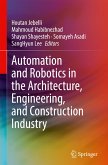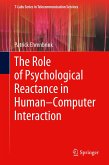Automation and Robotics in the Architecture, Engineering, and Construction Industry
Herausgegeben:Jebelli, Houtan; Habibnezhad, Mahmoud; Shayesteh, Shayan; Asadi, Somayeh; Lee, SangHyun
Automation and Robotics in the Architecture, Engineering, and Construction Industry
Herausgegeben:Jebelli, Houtan; Habibnezhad, Mahmoud; Shayesteh, Shayan; Asadi, Somayeh; Lee, SangHyun
- Broschiertes Buch
- Merkliste
- Auf die Merkliste
- Bewerten Bewerten
- Teilen
- Produkt teilen
- Produkterinnerung
- Produkterinnerung
Automation and Robotics in the Architecture, Engineering, and Construction Industry provides distinct and unified insight into current and future construction robotics, offering readers a comprehensive perspective for constructing a roadmap and illuminating improvements for a successful transition towards construction robotization. The book covers the fundamentals and applications of robotics, autonomous vehicles, and human-perceptive machines at construction sites. Through theoretical and experimental analyses, it examines the potential of robotics and automated systems for current and future…mehr
Andere Kunden interessierten sich auch für
![Automation and Robotics in the Architecture, Engineering, and Construction Industry Automation and Robotics in the Architecture, Engineering, and Construction Industry]() Automation and Robotics in the Architecture, Engineering, and Construction Industry149,99 €
Automation and Robotics in the Architecture, Engineering, and Construction Industry149,99 €![The Role of Psychological Reactance in Human-Computer Interaction The Role of Psychological Reactance in Human-Computer Interaction]() Patrick EhrenbrinkThe Role of Psychological Reactance in Human-Computer Interaction38,99 €
Patrick EhrenbrinkThe Role of Psychological Reactance in Human-Computer Interaction38,99 €![The Role of Psychological Reactance in Human-Computer Interaction The Role of Psychological Reactance in Human-Computer Interaction]() Patrick EhrenbrinkThe Role of Psychological Reactance in Human-Computer Interaction38,99 €
Patrick EhrenbrinkThe Role of Psychological Reactance in Human-Computer Interaction38,99 €![Human-Aware Robotics: Modeling Human Motor Skills for the Design, Planning and Control of a New Generation of Robotic Devices Human-Aware Robotics: Modeling Human Motor Skills for the Design, Planning and Control of a New Generation of Robotic Devices]() Giuseppe AvertaHuman-Aware Robotics: Modeling Human Motor Skills for the Design, Planning and Control of a New Generation of Robotic Devices104,99 €
Giuseppe AvertaHuman-Aware Robotics: Modeling Human Motor Skills for the Design, Planning and Control of a New Generation of Robotic Devices104,99 €![Human-Aware Robotics: Modeling Human Motor Skills for the Design, Planning and Control of a New Generation of Robotic Devices Human-Aware Robotics: Modeling Human Motor Skills for the Design, Planning and Control of a New Generation of Robotic Devices]() Giuseppe AvertaHuman-Aware Robotics: Modeling Human Motor Skills for the Design, Planning and Control of a New Generation of Robotic Devices104,99 €
Giuseppe AvertaHuman-Aware Robotics: Modeling Human Motor Skills for the Design, Planning and Control of a New Generation of Robotic Devices104,99 €![Recent Advances in Electrical Engineering, Electronics and Energy Recent Advances in Electrical Engineering, Electronics and Energy]() Recent Advances in Electrical Engineering, Electronics and Energy299,59 €
Recent Advances in Electrical Engineering, Electronics and Energy299,59 €![Recent Advances in Electrical Engineering, Electronics and Energy Recent Advances in Electrical Engineering, Electronics and Energy]() Recent Advances in Electrical Engineering, Electronics and Energy223,99 €
Recent Advances in Electrical Engineering, Electronics and Energy223,99 €-
-
-
Automation and Robotics in the Architecture, Engineering, and Construction Industry provides distinct and unified insight into current and future construction robotics, offering readers a comprehensive perspective for constructing a roadmap and illuminating improvements for a successful transition towards construction robotization. The book covers the fundamentals and applications of robotics, autonomous vehicles, and human-perceptive machines at construction sites. Through theoretical and experimental analyses, it examines the potential of robotics and automated systems for current and future fieldwork operations and identifies the factors that determine their implementation pace, adoption scale, and ubiquity throughout the industry. The book evaluates the technical, societal, and economic aspects of adopting robots in construction, both as standalone and collaborative systems, which in return can afford the opportunity to investigate these AI-enabled machines more systematically
Produktdetails
- Produktdetails
- Verlag: Springer / Springer International Publishing / Springer, Berlin
- Artikelnr. des Verlages: 978-3-030-77165-2
- 1st edition 2022
- Seitenzahl: 236
- Erscheinungstermin: 5. Januar 2023
- Englisch
- Abmessung: 235mm x 155mm x 13mm
- Gewicht: 365g
- ISBN-13: 9783030771652
- ISBN-10: 3030771652
- Artikelnr.: 66883703
- Herstellerkennzeichnung Die Herstellerinformationen sind derzeit nicht verfügbar.
- Verlag: Springer / Springer International Publishing / Springer, Berlin
- Artikelnr. des Verlages: 978-3-030-77165-2
- 1st edition 2022
- Seitenzahl: 236
- Erscheinungstermin: 5. Januar 2023
- Englisch
- Abmessung: 235mm x 155mm x 13mm
- Gewicht: 365g
- ISBN-13: 9783030771652
- ISBN-10: 3030771652
- Artikelnr.: 66883703
- Herstellerkennzeichnung Die Herstellerinformationen sind derzeit nicht verfügbar.
Houtan Jebelli, Ph.D., is an Assistant Professor in the Department of Architectural Engineering and Affiliate of the Institute for Computational and Data Sciences at the Pennsylvania State University. He earned his Ph.D. in Civil Engineering from the University of Michigan. He received his bachelor¿s degree in Civil Engineering from Tehran Polytechnic University and an MSc in Structural Engineering from the Sharif University of Technology. Dr. Jebelli completed a second MSc in Construction Engineering and Management from the University of Nebraska-Lincoln. While pursuing his Ph.D., he received his third MSc in Electrical Engineering and Computer Science. Dr. Jebelli is Director of the Robotic, Automation, and Intelligent Sensing (RAISE) Lab. Dr. Jebelli's research group at Penn State explores novel approaches that infuse human physiology into robotic control and motion planning system to augment awareness and adaptation between workers and robots. His team's other thematic priorities involve physiological computing for construction automation and safety, physiologically-enabled health monitoring of construction workers, brain-driven approaches for teleoperation, and personalized worker-robot collaboration and co-adaptation at construction sites. He has received several awards and fellowships, including the Charles M. Eastman Top Ph.D. Paper Award, two Outstanding Thesis Awards, the Rackham Research Grant, the John L. Tishman Fellowship, and the Calvin C. Solem Foundation Fellowship. He serves as a reviewer for a number of journals and symposia and is an active member of professional communities like the ASCE Data Sensing and Analysis (DSA) and ASCE Visualization, Information Modelling, and Simulation (VIMS) committees. Mahmoud Habibnezhad, Ph.D., is a Postdoctoral Scholar in the Department of Architectural Engineering at the Pennsylvania State University. He received his BSc in Civil Engineering and first MSc in Structural Engineering from the Sharif University of Technology. He received his second MSc in Computer Science and his Ph.D. in Construction Engineering and Management from the University of Nebraska-Lincoln. Dr. Habibnezhad's current research strives to develop convergent approaches to promoting safety and productivity at construction sites by transforming manual construction activities into semi- or fully automated operations. In the realm of human-technology interaction, his research contributes to intuitive control of human-operated assistive machines, digital twins for cyber-physical systems, and the development of safety-critical training platforms for future machinery-dominated construction sites. Dr. Habibnezhad has a successful record of publications in immersive technologies, physiological computing, computer vision, and human-robot collaboration and adaptation, all with the focus on construction safety. He also serves as a reviewer for a handful of peer-reviewed journals, including Automation in Construction, Virtual Reality and Intelligent Hardware, Applied Sciences, and Journal of Construction Engineering and Management. Shayan Shayesteh is a Ph.D. student in the Department of Architectural Engineering at the Pennsylvania State University. He received his BSc degree in Civil Engineering from the University of Tehran in 2016. He also received his MSc degree in Construction Engineering and Management from the University of Tehran in 2019. His research focuses mainly on exploiting immersive technologies to improve worker-robot partnerships at construction sites. He explores different aspects of human-robot interaction and their impact on various human factors through the application of wearable biosensors. By overcoming the challenges ahead, he aims to develop an innovative training platform for human-robot collaboration at construction workplaces. Somayeh Asadi, Ph.D., is an Associate Professor in the Department of Architectural Engineering at The Pennsylvania State University. Prior to that, she was an Assistant Professor at Texas A&M University. Dr. Asadi's research interests focus on automated design, critical infrastructure systems, food-water-energy nexus, the design of high-performance buildings, and environmental sustainability. She serves on the Editorial Board of the Journal of Advanced Materials Research and the Journal of Environmental Conservation Research, has obtained funding from diverse sources, including the Pennsylvania Department of Environmental Protection, the Department of Energy, the Qatar National Research Fund, and the National Science Foundation, and published more than 70 journal and conference papers. SangHyun Lee, Ph.D., is a Professor and John L. Tishman Faculty Scholar at the University of Michigan, where he is also the Associate Department Chair of Research for the Department ofCivil and Environmental Engineering. He received both his MSc and Ph.D. from the Massachusetts Institute of Technology. His research focuses on improving occupational safety and health with computer vision, wearable technologies, and computer simulation. Dr. Lee is the founder and CTO of Kinetica Labs in Ann Arbor, a pioneer in developing sensing and simulation technology for occupational safety and health. He has received numerous awards, such as the ASCE Daniel W. Halpin Award for Scholarship in Construction and the ASCE Thomas Fitch Rowland Prize, and is the Associate Editor of the ASCE Journal of Computing in Civil Engineering and Specialty Editor of the ASCE Journal of Construction Engineering and Management.
Automation and Robotics Technologies Deployment Trends in Construction.- Essential Knowledge, Skills and Abilities Required for Talent Cultivation in Construction Automation and Robotics.- Robotics and Automation in Construction (RAC): Priorities and Barriers toward Productivity Improvement in Civil Infrastructure Projects.- Construction Automation and Sustainable Development.- A Briefing on Technological, Societal, and Economical Aspects of Automation in Construction.- Human-Drone Interaction (HDI): Opportunities and Considerations in Construction.- Safety Challenges of Human-Drone Interactions on Construction Jobsites.- Assessing the Role of Wearable Robotics in the Construction Industry: Potential Safety Benefits, Opportunities and Implementation Barriers.- Fault-Tolerant Physiology-aware Signal Classification Algorithm for Robust Decisions in Perceptive Robotics Systems.- Workers' Trust in Collaborative Construction Robots: EEG-Based Trust Recognition in an Immersive Environment.- Index.
Automation and Robotics Technologies Deployment Trends in Construction.- Essential Knowledge, Skills and Abilities Required for Talent Cultivation in Construction Automation and Robotics.- Robotics and Automation in Construction (RAC): Priorities and Barriers toward Productivity Improvement in Civil Infrastructure Projects.- Construction Automation and Sustainable Development.- A Briefing on Technological, Societal, and Economical Aspects of Automation in Construction.- Human-Drone Interaction (HDI): Opportunities and Considerations in Construction.- Safety Challenges of Human-Drone Interactions on Construction Jobsites.- Assessing the Role of Wearable Robotics in the Construction Industry: Potential Safety Benefits, Opportunities and Implementation Barriers.- Fault-Tolerant Physiology-aware Signal Classification Algorithm for Robust Decisions in Perceptive Robotics Systems.- Workers' Trust in Collaborative Construction Robots: EEG-Based Trust Recognition in an Immersive Environment.- Index.








